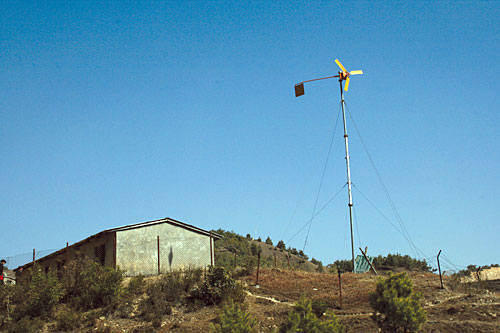 PUSHKAR MANANDHAR HARNESSING NATURE: A turbine built by Practical Action in Pakhel, Makwanpur. |
A crippling power shortage that is here to stay, ease of installation and affordability are making experts take a fresh look at windpower in Nepal.
There was optimism in abundance at a recent National Workshop on Wind Energy, organised by the Alternative
Energy Promotion Centre (AEPC) and Tribhuvan University.
"This is the first time I have seen so many people keen on windpower," commented Rakesh Sinha, a researcher at a windpower company.
A mix of public and private stakeholders were invited, after a nine-year lull, to exchange experiences and review the draft national wind policy, recently prepared by the National Wind Task Force (NWTF). The paper intends to draw foreign investment for utility-scale wind turbines, particularly through the construction of a model project generating more than 500KW. It also means to protect the interests of local manufacturers of small wind turbines no larger than 10KW.
"We should hand over the draft policy to the ministry in the next three months. Parliament should pass it within six months, after which we hope to pilot a commercial wind farm in a year," says NWTF member Manoj Kumar Mishra.
Government, private sector and non-governmental organisations have invested intermittently in windpower over the past three decades. In 1989, two wind generators of 10KW capacity each were built in Kagbeni, Mustang, but both were blown down by high winds. This deterred further interest in windpower.
With power cuts, windpower has gradually regained credibility as a viable, quick, and possibly cheap solution. "In the past when one brought up wind energy, government officials would respond with hawa ma kura garne (talking in the wind). This is no longer the case," says Govind Pokharel, formerly of AEPC. Windpower is quick to install and offsets carbon emissions by reducing deforestation and consumption of imported petroleum-based products.
Nepal presently has some small-scale, stand-alone wind turbines. AEPC has built six wind-solar hybrids - 400W wind and 150W solar - each capable of supplying a community of about 10 residences with enough energy to run one radio and a CFL bulb. Practical Action has invested in 18 small wind turbines of 200W capacity each since 2001. The army has constructed 10 larger turbines of 1KW in Nagarkot and students at Kathmandu University have designed and set up two 1.5KW turbines, using local material such as sal wood. Small wind turbines and wind mills have been installed by private companies and investors. AEPC also subsidises projects generating electricity to benefit remote areas that can't access the national grid.
All this is falls far short of Nepal's 3000MW potential, as identified by a study on only 10 per cent of the total feasible area. Mustang alone could generate 500GWh a year.
"To make windpower commercially viable on a large scale, one needs to prepare a national wind map with five years of consistent data," says Tri Ratna Bajracharya, Director of the Center for Energy Studies at Tribhuvan University. But no measurements have been taken of elevations above 30 metres, the baseline for commercial production of wind.
Lack of data has also delayed reliable estimates of the Cost of Energy (CoE), and the lack of transportation and grid infrastructure in potential sites is a barrier to developing utility-scale wind farms. Tax regulation, purchasing power agreements, license distribution, land ownership and subsidies need to be agreed on before the draft national wind policy is finalised.
With political will and private sector interest as much as sheer necessity, however, windpower seems poised to
take off.


